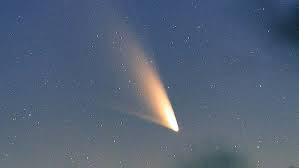For what it's worth, Comet PANSTARRS has arrived

As of last night, Comet PANSTARRS (left) is visible to us in the Northern Hemisphere.
As it happens, PANSTARRS was the closest it is going to get last night, and will now begin fading. Don't make the mistake I made with Comet McNaught, and wait too long to look for it!
But don't expect it to look like the picture, taken south of the equator several days ago. The elongation of the stars in the picture is a good indication of the length of the exposure necessary to get a picture this good.
Look to the unobstructed west around and very briefly after sunset. You will probably need binoculars, and it will help to be as far as possible from city lights. The comet may be visible-barely- to the naked eye, but magnification will almost certainly be requried to see the tail(s).
Above is a chart of where PANSTARRS will be in coming days. Deo volente, you won't need a chart- or binoculars- to find Comet ISON this November!



Comments